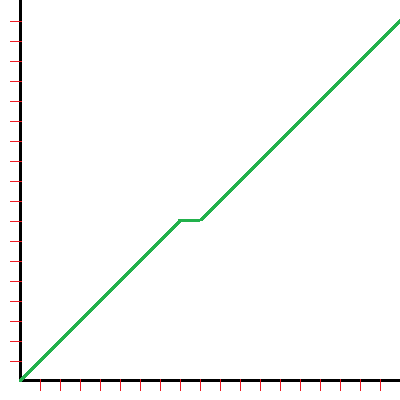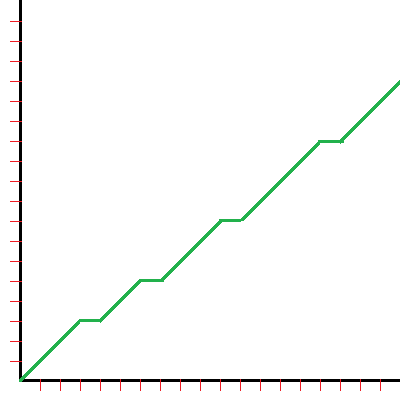Pattern Recognition #67 - Mana Curves
Features Opinion Pattern Recognition
berryjon
10 May 2018
2000 views
10 May 2018
2000 views
Hello everyone! I am berryjon, your resident Old Fogey. Welcome back to Pattern Recognition, Tappedout.net's most regular article series - barring the occasional week off for work or just because I'm out of energy. I endeavor to provide insightful, thought provoking and educational material for you all. Or at least a convenient target for all of you to aim your Mizzium Mortars at.
Today, I promised pictures, and I shall deliver! Or at least I hope.
But in reality, I want to look at something that I felt needed to be addressed after going to the Dominaria pre-release with my sister-in-law. And no, it's not the way the packs were sorted. Seriously, Three Kazarov, Sengir Pureblood and two Jodah, Archmage Eternal in one pre-release box? Something was screwy there, and I'm not talking about Mana Screw.
No, what I want to talk to you guys today about is the subject of the Mana Curve.
This isn't exactly an easy subject to write about as there is a lot of nuance involved, but let me first break it down into two over-reaching themes and from there I can move into some of the details.
But first, a definition for all of us to be on the same page over. The Mana Curve is, for the purposes of this article, defined as the confluence of the distribution of mana costs for spells in a deck when compared to the expected amount of mana available to the deck on each turn.
That's a whole lotta words, and trust me, it isn't going to get much better for a while. But for the first part, let's look at the latter half of that definition, namely, just how much mana can you expect to have on a given turn.
To answer that question, we need to look at two things. Both of which go into the nature of deck construction and how mana comes into play.
First of all, take a look at the following graphic. It shows the available mana to a given deck on each turn, assuming that they play a land each turn.

Behold, the mighty power of MS PAINT! But regardless of you see my presentation, what you see here is what is called linear growth. That is, for each turn, you have exactly that amount of mana available for you to spend. Turn 1, 1 mana. Turn 2, two mana. Turn 12, twelve mana.
But what happens when you miss a land drop? Well then, your available mana looks more like this:

That little stagger in the line represents such a turn, where you missed out, and your available mana becomes equal to your turn number minus one. But what happens to your available mana when this happens multiple times in a game? Well, you start to look like this:

And if your upward slope starts to look less like stairs and more like a floor, well then, you've hit the magical land of Mana Screw.
Now, on the opposite end of this is the idea of Ramp. This is a term used most often in conjunction with Green cards that allows you to have more mana on any given turn than than that turns number. Cards like Llanowar Elves, or Kodama's Reach or the ever-used-in-Commander Sol Ring. Or Cloudpost, which provides exponential growth, same as Powerstone Shard. When that happens, your available mana starts to look more like this:

Huzzuh!
Now, I could spend multiple articles talking nuance about the nature of ramp and mana acceleration, but that's not here and now. What I do need to impart is that what happens in theory, and what happens when cards hit the table can be quite different.
Now, onto the first half of my definition, and one far more complicated. I want all of you to break out a random deck of yours, and start sorting the cards out by their converted mana costs. Line then all up like you're playing solitaire, with "Zero" for cards like Mox Amber on the left, and with each new column being the next number up. Ones, Twos, Threes, and keep going until you have all your cards in order, leaving spaces where you have no cards that cost that amount, and remember that counts for nothing.
What you have here before you, is your deck's Mana Curve in a visual format.
And guess what! TappedOut.Net's deck building engine actually has this as part of its basic functions! Just look at your deck on the site, or any old deck for that matter, and look on the right hand side of the page. You'll see a pie chart showing off where you get your mana from, as well as the total proportion of colours in your sources and required by your deck. Then you'll see another pie chart which shows off how much of your deck is each card type, and then you'll see a bar graph showing off how much each card in your deck costs, sorted by colour.
Oh, and the best part is? It's interactive. Clicking on any of these sections will highlight the relevant cards in the card list in the middle of the page. Want to see how many cards you have in your deck cost three, and are in white? It's just a single click on the bar graph away!
Now that you know what you're looking for, it's time to break down how some decks handle their mana curves. Let's start with a couple of examples from previous decks I've built for Pattern Recognition.
The Aggro Archetype is very easy to plot out, thanks to the intent behind it. Because the deck tries to end the game as soon as possible, an Aggro deck will focus mainly on low-cost cards with the expectation that your hand will be full of cards that you can cast each turn, and that you will need to cast them each turn to make maximal use of your available resources.
Generic RW Aggro
Modern
905 VIEWS | IN 1 FOLDER
This deck, from when I talked about the differences between Aggro, Combo and Control, shows off this theme quite directly. 18 cards with a cost of 1, 17 with a cost of 2. That's 35 cards in the deck that can be played on Turn 1 and Turn 2. There are only four cards with a cost of 3 in the deck, and three with a cost of 4. After that, there is nothing.
Here's the thing about this deck. The mana 'Curve' is more like a mana 'Cliff'. You hit your sweet spot - in this case it's Two mana sources, one each of Red and White, and you're set to win the game. Everything after that is just "Win Harder".
And Aggro Decks all follow this paradigm. They chose a certain cut off point for the cost of their cards - usually for their deck, and fit everything they can under that line due to the theory that everything after that point won't matter.
On the other hand, this can be flexible. Look at this deck back from when I first started:
Cheese it, It's the CoPs!
Modern
SCORE: 34 | 24 COMMENTS | 3044 VIEWS | IN 15 FOLDERS
Hrm, need to consider putting Knight of Grace into this now, but that's for a different time. Instead, have a look at the mana curve of this deck. It's a bit more gentle, having more cards that cost 4, 5 and even 7! But this deck also recognizes that the biggest effects, the majority and meat of the deck occurs at a cost of and .
This is the core of Aggro decks. Lots of cheap cards, and fewer and fewer cards that cost more.
Moving on to the next archtype, it isn't Control but it does share many similar effects. The Midrange deck is one that yields in the early game in order to establish a firm grasp of options later on.
The Lumbermill
Modern
SCORE: 9 | 1223 VIEWS | IN 2 FOLDERS
This deck is a deck that I like to think of as mid-range in practice, despite having a more Aggro-approach to its mana curve. It works the long game, keeping plenty of mana open to react to the opponent, rather than taking a more active approach.
Keeping it Simple, Silly
Modern
SCORE: 27 | 14 COMMENTS | 2147 VIEWS | IN 9 FOLDERS
On the other hand, I do think that this card is more representative of the Midrange philosophy as the key card in the deck is Muraganda Petroglyphs, costing , which means that this deck is ready to roll just as the typical Aggro Deck is winding down.
You know, I'm going to borrow zandl's decks for a moment here, and show two of his that are better mid-range and Control in style. Because I'm an Aggro Player, and he isn't!
Teferi, Hero of Dominaria
Standard Brawl*
SCORE: 1 | 56 VIEWS
deck-large:04-04-18-uPI-sultai-control
These two decks show off the more traditional bell-curve of control styled decks, with a weak start, a strong selection of spells in the middle of the deck (cost wise, not in that range 20-40 cards down) and a few end-game bombs of closing out the game.
And now for the last major archetype. Combo.
Well now, this is actually interesting. Let's look at a curve for Combo now, shall we?
To Infinity and Beyond
Modern
SCORE: 12 | 6 COMMENTS | 1592 VIEWS | IN 5 FOLDERS
Now, before you complain that this is another Aggro Deck curve (I'm sorry! I have a bias!), I want to point out the difference between the two. That being that in a Combo Deck, the core components to the combo itself go into the deck first (in this case, the Ornithopter and Grinding Station or the Wild Cantor and Grapeshot, both of which require Enduring Renewal to work properly. Now, the deck only looks aggro in function simply because the key components are all quite cheap. But you'll also notice the conspicuous gap in the mana costs at 3, because nothing in the deck serves the combo that fits there.
That's the difference. In a Combo deck, the costs of the pieces come first, while in other decks, the cost of the cards are judged relative to each other and not to some objective standard. In a Combo deck, a mana curve can fluctuate wildly just so long as the deck performs reliably rather than performing the same actions every turn, every game.
So, what do these two sides have to do with each other?
Well, the Mana Curve to a deck is more than just the costs of the cards. I think I've already said that, but it bears repeating. It is also about having the right amount of mana to do the job you want it to do. What is the point of having 7 available mana on turn 3 when you run out of cards to play, or you have nothing in hand or your deck that requires that much to bring out.
Unless, of course, you're playing Commander and it's already gone back to the Command Zone once or twice. Somehow in the first couple turns. What are you doing, playing Oviya Pashiri, Sage Lifecrafter as your Commander, and losing her so often?
Never mind. Don't answer that.
A deck's mana curve is about making sure that your available resources match what you want to play at any given time. Aggro decks don't need a lot of mana, so they can settle for less in the deck with more cheap cards to help fill in the gaps. Midrange can utilize a certain degree of reliability through the game, but can equally do without any for of acceleration. And if you're going to ramp, ramp with a purpose and not just because you like the bigger numbers on your Omnath, Locus of Mana.
And yet, there's more still! If you play a land for your first four turns, how much mana do you have? No, not . You actually have mana. You see, your available resources is slightly cumulative. No, not Cumulative Upkeep. What makes you think that?
This ten mana can change how you look at your hand. Imagine if you could compress your entire first four turns into a single one, how would you spend it if you were limited to a chunk of , , , and ?
You can now look at your deck in a different manner, and that can change everything.
Yet more importantly, will you keep a pace with one card each turn, or will you play more than one? What will your tempo be in this case? Aggro? Control? Midrange? Combo?
So, let me know what you think a good mana curve for your deck looks like. Are you the kind of person who runs it lean, and tight to the cost of the cards? Or do you prefer to have a bit of leeway, if only to bluff your opponent into thinking you have a Cancel in your hand and not a Negate?
Join me next time, when I talk about something. I'll come up with a subject, I'm sure.
Until then, please consider donating to my Pattern Recognition Patreon. Yeah, I have a job, but more income is always better. I still have plans to do a audio Pattern Recognition at some point, or perhaps a Twitch stream. And you can bribe your way to the front of the line to have your questions, comments and observations answered!
Good point there. But when you're dealing with Fireball or Braingeyser, what would be?
May 10, 2018 8:21 p.m.
You definitely want to treat Fireball et al. at some average value because you will certainly never be casting it with an X of 0.
May 10, 2018 10:27 p.m.
rob_shifflett says... #4
I would count the Fireball\Braingeyser in every applicable Mana slot.
So, Fb would be counted in the 2-11 slots and Bg would be in the 3-6 slots. Decks playing Bg will want a chance to be able to use at least one of those cards before their next turn, whereas the FB caster will probably be tapping out for it.
May 10, 2018 10:37 p.m. Edited.
I think this is a bit too nitpicky, as there is no hard rule on these x-costs. Usually, x-costs are not generally a big part of your deck - a limited deck may have 2-3 of them tops and similarly for constructed, since even though they scale, they rarely scale well enough. I would say these are best counted at the lowest you would be happy to play them, but considering them a bit wrongly on the curve is hardly detrimental.
May 11, 2018 4:11 a.m.
Counting sorceries and instants into mana-curve is just a recipe for frustration. Fireball and other x-damage should probably fit 5+ mana, since if you play it cheaper on a regular basis, there are plenty of cards that are better and you should play instead.
And that's not even considering where you'd slot in counterspells and removal. Path to Exile is occasionally played in turn 1, but mostly it's played somewhat later, simply because there aren't that many threats on turn 1 calling for that kind of removal - and then it doesn't make sense calculating it as one of your decks 1 cmc spells. But where does it then go?
May 11, 2018 10:26 a.m.
Refer to the mana growth charts above and compare that to a mana bell-curve of a deck that uses removal or counters in this way. Typically, you'll see them both stretch positively upwards for the first couple of turns, afterwards the bell-curve will level-out, and then dip off while the mana growths stays somewhat consistently linear. That gap between these graphs are where you'll expect to start playing more spells per turn. Check out the curve on this deck:
Total Control - Faerie
Modern
SCORE: 4 | 6 COMMENTS | 942 VIEWS | IN 4 FOLDERS
By the time i get to turn 3 or 4, I won't just be relying so much on my 3-4 mana cost cards, but rather through the combos I can achieve by casting more than one of the less costly spells, or activating multiple Artifact abilities!
While sorting your deck by the turn the cards are expected to come out may be beneficial, the mana curve as is goes beyond the turn-by-turn structure to give you a more accurate way to pace your deck! The relationship between your mana curve and your turn-by-turn expectations is your Tempo!
May 11, 2018 3:01 p.m.
I disklike yozr defenition of mana curve to be honest. Sure the amount of mana you axpect to have on a certain trun should be considered when you are looking at your curve. the amount of lands (or other mana sources) should be chsose accordingly to your mana curve. But the mana curve is certainly not the confluence of both. Its the curve that assings the number of spells for any given cmc to that cmc.
May 13, 2018 10:26 a.m.
Well that's a bit on-the-nose, but you're right. The mana curve is literally just a bar graph that groups similar-CMC spells together, but if that's all you see, then you are severely under-utilizing your data!
The confluence between land-and-turn that you're referring to (one land by turn one, two lands by turn two, miss a land-drop on turn three, three lands by turn 4, etc) is represented by the graphs in the above article that were mentioned in my previous comment. This land-and-turn chart (just like the mana curve) is ultimately useless by itself, but by knowing your land-and-turn needs, your mana curve, and just a bit of game theory, you can significantly reduce the likelihood of mana flooding, mana screw, or 'bad' opening hands. This in turn stabilizes your decks tempo (or play consistency) and even makes you less susceptible to disruption!
May 13, 2018 12:11 p.m.
Yeah of course and thatd exactly what i said when I was talking about when I said that you should keep the amounts of lands in Mind when you look at your mana curve.
But that doesnt make it part of the mana curve. Its a separate piece of data and you should combine them when you want to build a deck but they are not the same thing. This defenition simply doesnt make sence. Thats all i was talking about.
May 13, 2018 2:27 p.m.
I'm having trouble understanding the distinction you're making between what I'm saying and what you're saying here; I agree that lands are not factored in to create a mana curve. I'm saying that the combination of these two very distinct things is exclusively what makes either thing at all relevant. This magical combination is responsible for most (or all, depending on your deck) of your deck's tempo.
Knowing the distribution of your mana costs doesn't help you unless you know what you can expect from your mana production. Similarly, knowing your rate of mana production doesn't help you unless you know what to expect from the mana costs of cards you draw.
I think the definition you're referring to is my description of the correlation between your mana curve and your tempo, but I tend to get a little wordy, so I can understand where I may not have been clear!
May 13, 2018 5:04 p.m.
Im reffering to berryjons defwnition of mana curve not to yours
I should have made than clear in my first postI wasnt reffering to you at all.
May 13, 2018 6:31 p.m.
KingofCorns says... #14
I reckon the amount of lands you put in your deck is more representative of how you want it to operate and isn't necessarily shaped because of your mana curve. Examples:
My Grenzo, Dungeon Warden deck peaks hard at 2 cmc but isn't after an early aggro game. It doesn't need much land as long as Grenzo can get played earlyish.
My Sultai deck relies on 3+ land drops a turn into a Villainous Wealth for 30+, it has 45 lands and enough mana/card draw/ramp to play whatever, so the curve doesn't matter.
May 14, 2018 11:37 a.m.
KingofCorns says... #15
berryjon, I completely discount them from my curve, because they can fit in there anywhere. I love casting them for ridiculously high amounts so I image they're beyond the graph.
May 14, 2018 11:41 a.m.
I like all the comments you guys have been having. Which makes my inability to put out an article this thursday all the more disenheartening.
I have this weekend off though, so I should be able to crunch out one or two to make up for it. Do you guys have any requests for articles?
May 14, 2018 9:46 p.m.
When Im determining my mana curve, I always arrange them by expected converted mana cost. Cards that have alternative casting costs like overload, kicker, transmute and such I always put in the slot at which I generally expect to cast that card for. For example, Cyclonic Rift is a 7-drop because you generally want to be casting it with overload. Mulldrifter I consider usually a 3-drop for that same reason.
Spells with X in their casting cost can be harder to place, though X is usually one or more in most cases so I wouldnt rank them with X is zero. Only exception is probably Green Suns Zenith when running Dryad Arbor. For all the other X spells more mana is better, so if I cant determine an average cost for it Ill put it in my seven mana and more pile. They can of course be cast for less if need be, but in the least it keeps me prepared for casting it at a higher cost.
This way I can adjust my mana sources to my actual needs, or in some cases determine if the top end needs some trimming down so my curve doesnt hamper my ability to cast my spells like I want them.
May 15, 2018 4:34 a.m.
Myr_Mythic says... #18
Segueing into an article on Mana fixing would be efficient, and could conceivably be extended into a second article on color balance.







Myr_Mythic says... #1
I'd like to argue against putting x-costs as zero. In practice, one almost never casts an x card for 0. Instead, one would be more accurately served by putting cards at the minimum cost that nets a worthwhile effect. Astral Cornucopia would be placed with the other 3-drops, for example.
May 10, 2018 7:53 p.m.